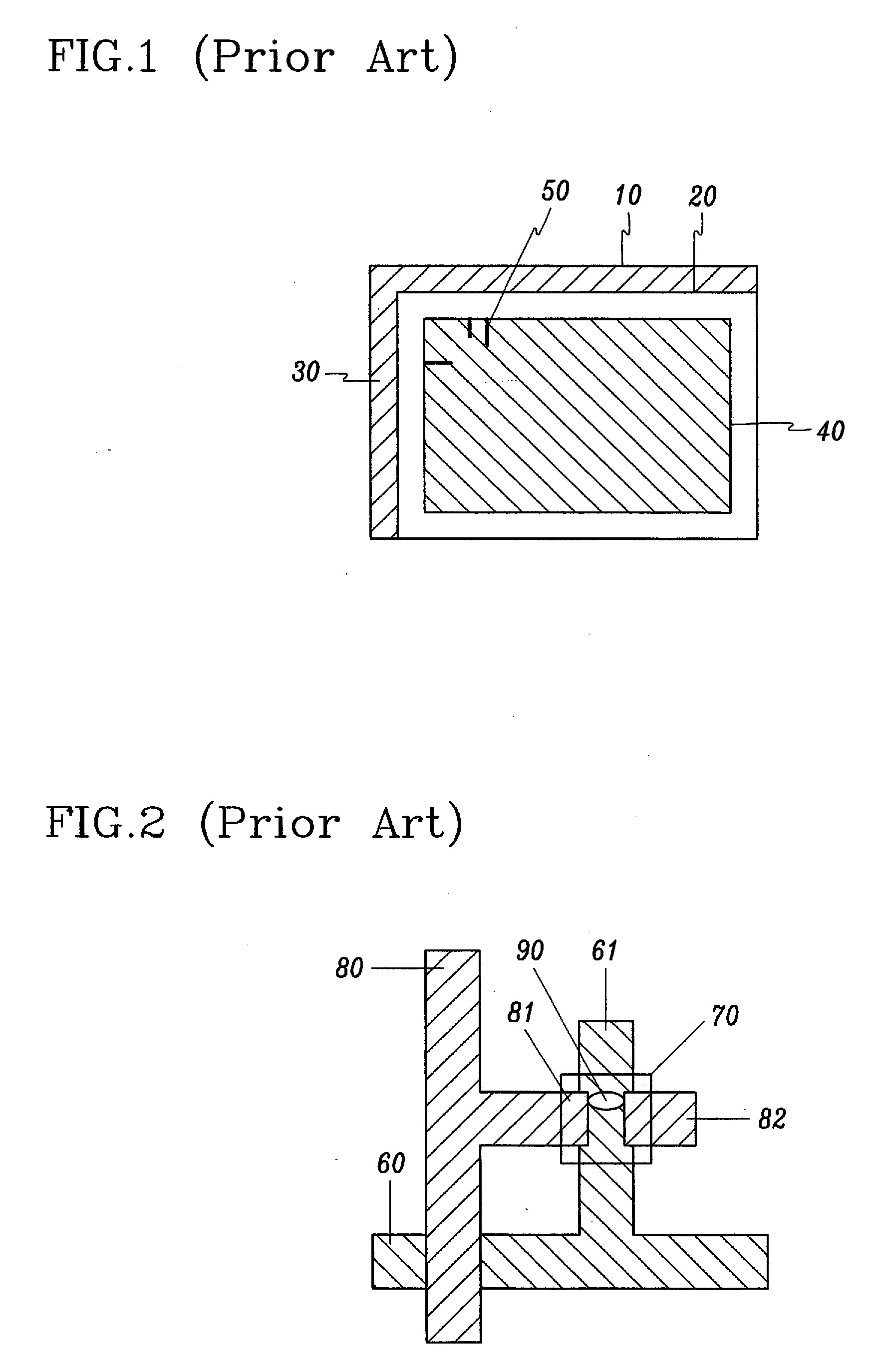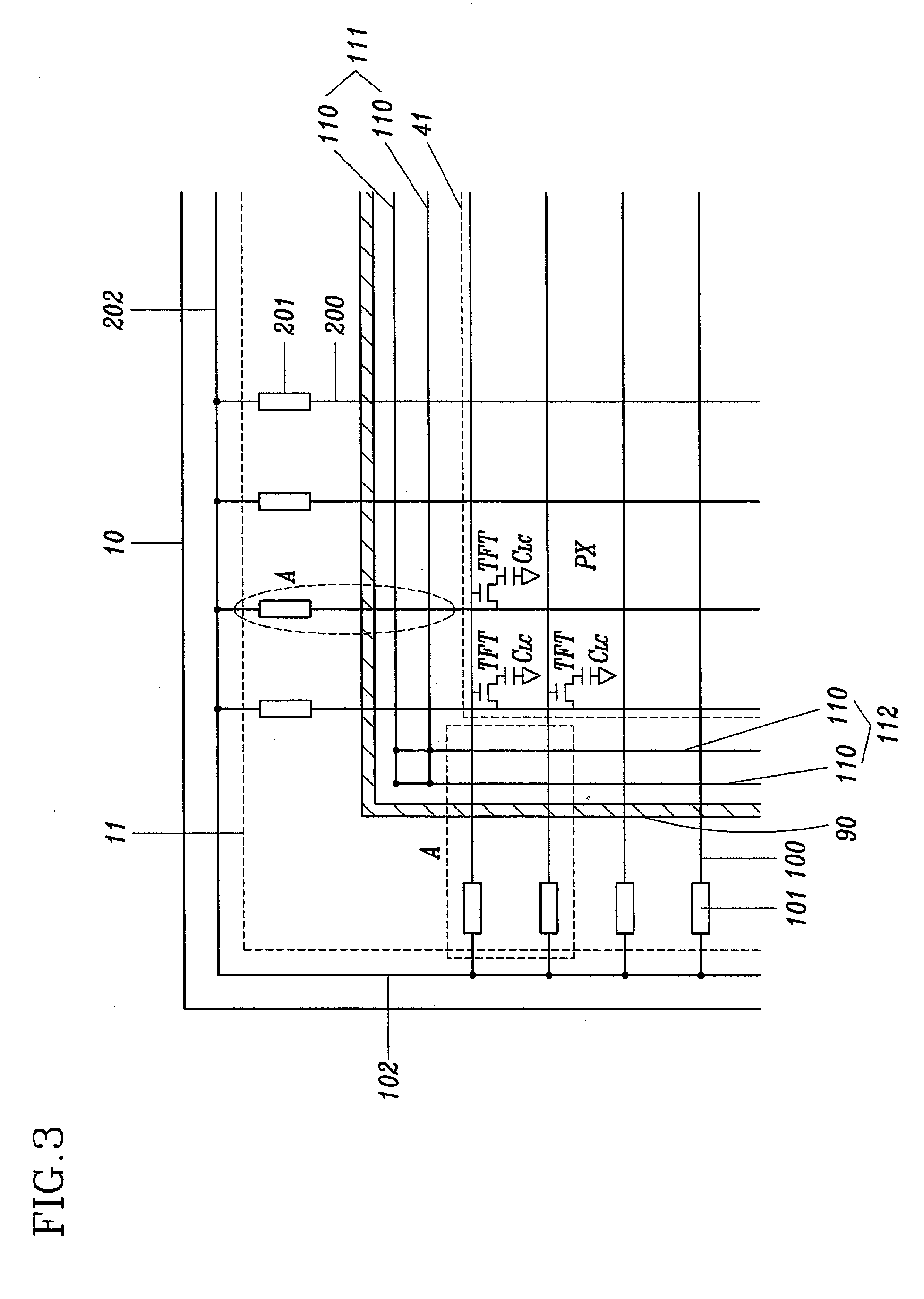Thin film transistor array panel
a transistor array and thin film technology, applied in non-linear optics, instruments, optics, etc., can solve the problems of reducing the quality of the substrate, reducing the efficiency of the lcd manufacturing process, and easy damage of the tft channel near the pad, so as to minimize the defect of the pixel and reduce the manufacturing cos
- Summary
- Abstract
- Description
- Claims
- Application Information
AI Technical Summary
Benefits of technology
Problems solved by technology
Method used
Image
Examples
second embodiment
[0079]FIG. 6 is an enlarged view of the area A in FIG. 3 according to a second preferred embodiment of the present invention. In the second embodiment, electrostatic discharge protection circuits are located inside the area enclosed by the seal area 90.
[0080] As shown in FIG. 6, spark inducing circuits 130 are connected to wires 100 at the position between the seal area 90 and the active area line 41, and electrostatic discharge protection diode circuits 120 are connected to the wires 100 as in the previous embodiment. First and second electrostatic charging circuits (not shown) may be provided inside the area enclosed by the seal area 90.
[0081] A various types of the spark inducing circuits 130 according to the preferred embodiments are shown in FIGS. 7 to 11. First to fourth spark inducing circuits ST1, ST2, ST3 and ST4 will be described with reference to FIGS. 7 to 10, respectively, the first to fourth spark inducing circuits ST1, ST2, ST3 and ST4 representing the different type...
first embodiment
[0120] As described in the electrostatic charge discharging pattern of the first embodiment, the ends of the first to the fourth electrode pattern 118, 128, 119 and 129 are pointedly formed. The first and the third electrode patterns 118 and 119 respectively face the second and the fourth electrode patterns 128 and 129. The first and the second patterns 118 and 128 are formed on the first amorphous silicon pattern 704, and the third and fourth patterns 119 and 129 are formed on the second amorphous silicon pattern 705. Thus, the electrostatic charges flowing through the dummy data line 110 are discharged to the ITO pattern 302 for the capacitor through the pointed portion and stored in the capacitor. The number of the discharging devices D1 and D2 which are connected to the dummy data line 110 may be increased as required.
[0121]FIG. 24 shows a layout view of a electrostatic charge discharging pattern according to a third preferred embodiment of the prevent invention. As shown in FIG...
fourth embodiment
[0124] The electrostatic charge discharging pattern of the fourth embodiment can discharge electrostatic charges more effectively because one more capacitor is formed in the step of forming wires in the substrate.
[0125] Now, a manufacturing method of the electrostatic charge discharging patterns will be described hereinafter with references to FIGS. 21 to 25, and FIGS. 26A to 26F.
[0126] As shown in FIG. 26A, a metal layer for gate wires is deposited on a substrate 10 and patterned to form a gate line and a dummy gate line 100 respectively inside and outside. In the case of the electrostatic charge discharging pattern of the fourth preferred embodiment, a dummy metal line 130 is formed outside an active area in parallel with the gate and the dummy gate line 100 in this step.
[0127] As shown In FIG. 26B, a gate Insulating film 3 is deposited with silicon nitride or silicon oxide. Next, an amorphous silicon and a doped amorphous silicon are deposited and then patterned to form an amor...
PUM
| Property | Measurement | Unit |
|---|---|---|
| conductivity | aaaaa | aaaaa |
| insulating | aaaaa | aaaaa |
| semiconductor | aaaaa | aaaaa |
Abstract
Description
Claims
Application Information
 Login to View More
Login to View More - R&D
- Intellectual Property
- Life Sciences
- Materials
- Tech Scout
- Unparalleled Data Quality
- Higher Quality Content
- 60% Fewer Hallucinations
Browse by: Latest US Patents, China's latest patents, Technical Efficacy Thesaurus, Application Domain, Technology Topic, Popular Technical Reports.
© 2025 PatSnap. All rights reserved.Legal|Privacy policy|Modern Slavery Act Transparency Statement|Sitemap|About US| Contact US: help@patsnap.com



